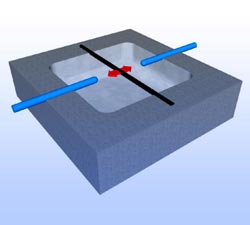Quantum computers counting on carbon nanotubes

Like a guitar string nanotubes (black) can be clamped and excited to vibrate. An electric field (electrodes: blue) ensures that two of the many possible states can be selectively addressed. Image: M.J. Hartmann, TUM<br>
Carbon nanotubes can be used as quantum bits for quantum computers. A study by physicists at the Technische Universitaet Muenchen (TUM) has shown how nanotubes can store information in the form of vibrations.
Up to now, researchers have experimented primarily with electrically charged particles. Because nanomechanical devices are not charged, they are much less sensitive to electrical interference.
Using quantum mechanical phenomena, computers could be much more powerful than their classical digital predecessors. Scientists all over the world are working to explore the basis for quantum computing. To date most systems are based on electrically charged particles that are held in an “electromagnetic trap.” A disadvantage of these systems is that they are very sensitive to electromagnetic interference and therefore need extensive shielding. Physicists at the Technische Universitaet Muenchen have now found a way for information to be stored and quantum mechanically processed in mechanical vibrations.
Playing a nano-guitar
A carbon nanotube that is clamped at both ends can be excited to oscillate. Like a guitar string, it vibrates for an amazingly long time. “One would expect that such a system would be strongly damped, and that the vibration would subside quickly,” says Simon Rips, first author of the publication. “In fact, the string vibrates more than a million times. The information is thus retained up to one second. That is long enough to work with.”
Since such a string oscillates among many physically equivalent states, the physicists resorted to a trick: an electric field in the vicinity of the nanotube ensures that two of these states can be selectively addressed. The information can then be written and read optoelectronically. “Our concept is based on available technology,” says Michael Hartmann, head of the Emmy Noether research group Quantum Optics and Quantum Dynamics at the TU Muenchen. “It could take us a step closer to the realization of a quantum computer.”
The research was supported by the German Research Council (DFG) within the Emmy-Noether program and SFB 631.
Publication:
Quantum Information Processing with Nanomechanical Qubits
Simon Rips and Michael J. Hartmann,
Physical Review Letters, 110, 1205034 (2013) DOI: 10.1103/PhysRevLett.110.120503
Contact:
Dr. Michael J. Hartmann
Technische Universitaet Muenchen
Department of Physics, Emmy Noether research group
“Quantum Optics and Quantum Dynamics” (T 34)
85747 Garching, Germany
Tel.: +49 89 289 12884
Media Contact
More Information:
http://www.tum.deAll latest news from the category: Physics and Astronomy
This area deals with the fundamental laws and building blocks of nature and how they interact, the properties and the behavior of matter, and research into space and time and their structures.
innovations-report provides in-depth reports and articles on subjects such as astrophysics, laser technologies, nuclear, quantum, particle and solid-state physics, nanotechnologies, planetary research and findings (Mars, Venus) and developments related to the Hubble Telescope.
Newest articles

Properties of new materials for microchips
… can now be measured well. Reseachers of Delft University of Technology demonstrated measuring performance properties of ultrathin silicon membranes. Making ever smaller and more powerful chips requires new ultrathin…

Floating solar’s potential
… to support sustainable development by addressing climate, water, and energy goals holistically. A new study published this week in Nature Energy raises the potential for floating solar photovoltaics (FPV)…

Skyrmions move at record speeds
… a step towards the computing of the future. An international research team led by scientists from the CNRS1 has discovered that the magnetic nanobubbles2 known as skyrmions can be…





















